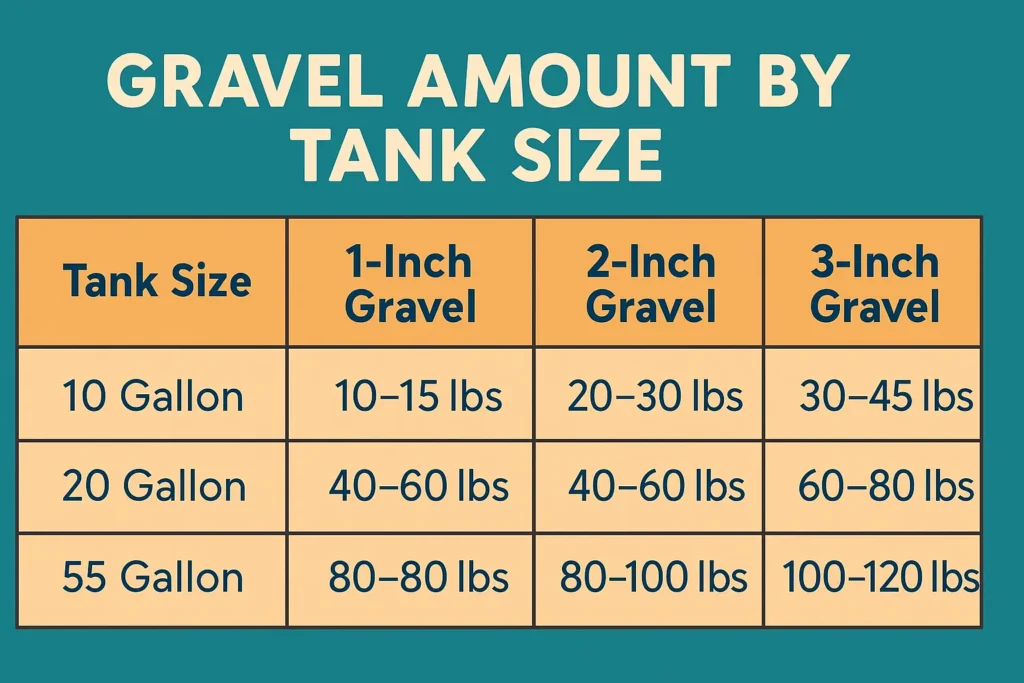🐠 Aquarium Gravel Calculator
Find the exact amount of gravel your aquarium needs based on tank size, dimensions, and preferred depth. Choose gravel type and unit system for accurate results.
Tank Setup
📦 Gravel Estimate Summary
Enter tank details above to calculate how much aquarium gravel you need.
Aquarium Gravel Calculator

Created by James S. Lockwood
With a background in botany and ecological sciences, James specializes in creating practical tools and resources to help gardeners, farmers, and plant enthusiasts optimize their green spaces.
Setting up an aquarium seems simple—until you’re standing in the store wondering whether you need a 10-pound or 40-pound bag of gravel. It’s one of those details that feels minor until it isn’t. That’s why using an aquarium gravel calculator can save you time, money, and frustration—not to mention spare your fish from an uneven or overpacked substrate.
This guide isn’t just about punching numbers into a calculator. It’s about understanding why you need a certain amount of gravel, how to calculate it based on your tank, and what mistakes to avoid.

Table of Contents
How Much Gravel Do I Need for My Aquarium?
Let’s start with a classic rule of thumb: 1 to 2 pounds of gravel per gallon of water. But is it really that straightforward?
It depends.
If you’re working with a lightly planted tank or one with only bottom-feeding fish, 1 pound per gallon might be enough. But for planted tanks that require root support, going closer to 2 pounds—or even more—makes a difference.
The aquarium gravel calculator helps remove the guesswork. Just plug in your tank’s length, width, and desired gravel depth, and it gives you a result in pounds or kilograms. It’s ideal for both rectangular and custom tanks.
According to aquarium setup recommendations from the University of Florida’s IFAS Extension, substrate depth plays a key role in filtration and plant root development, making accurate gravel calculation especially important.
Aquarium Gravel Chart (Tank Size vs Gravel Weight)
Here’s a quick look at how gravel needs vary by tank size and substrate depth. Even if you use a calculator, seeing the range helps frame expectations.

What’s surprising is how fast the weight adds up. You might think gravel is light—but try hauling three 20-pound bags from the store and you’ll rethink that.
Some hobbyists argue that you can get away with less if you’re going for aesthetics alone. That may work in minimal aquascapes, but it rarely suits tanks with plants or active diggers.
Recommended Gravel Depth
The debate around how deep your aquarium gravel should be is… ongoing.
Some swear by a 1-inch layer, especially for tanks with only decorations and minimal biological load. Others insist that 2 to 3 inches is a must for plant stability and proper bacterial colonization.
And honestly? Both sides have a point.
Shallow gravel is easier to clean and reduces the risk of anaerobic pockets. Deeper gravel, however, offers better anchoring and allows plants to thrive.
A good compromise is to aim for 1.5 to 2 inches as a standard. Use the aquarium gravel calculator to adjust based on your layout and fish.
Gravel vs Sand—What’s Better for Your Tank?
This is where things get murky.
Gravel offers better water flow and is less likely to compact. It’s ideal for tanks with undergravel filters and active fish like cichlids that enjoy sifting without clouding the water too much.
Sand, on the other hand, looks natural and smooth—perfect for bottom dwellers like corydoras or loaches. But it compacts faster and requires a different cleaning approach.
Still unsure? You can try the aquarium sand calculator to compare how much sand you’d need instead.
Some aquarists even mix both—though purists might roll their eyes. It’s not traditional, but sometimes, it works.
Gravel Type & Size Guide
Gravel comes in all shapes, sizes, and coatings. From fine pea gravel to polished quartz stones, the choices are overwhelming.
Here’s a breakdown:
Fine gravel (1–2mm): Great for plant roots, but harder to clean.
Medium gravel (3–5mm): The sweet spot for most tanks.
Coarse gravel (6mm+): Best for heavy decor but not ideal for plants.
Interestingly, some people choose gravel color and size solely based on aesthetic appeal. That’s fine—as long as the gravel is inert and doesn’t affect water chemistry.
If you’re replanting or upgrading your substrate, you might want to refer to this guide on how long before replanting aquatic plants.
Freshwater vs. Saltwater Gravel Needs
Freshwater tanks are more flexible. Inert gravel is often sufficient, and you can focus more on size and texture than composition.
Saltwater tanks, however, require careful planning. Many reef tanks use aragonite or crushed coral to buffer pH levels. Regular aquarium gravel doesn’t cut it here—it could even lead to imbalances.
That said, for fish-only saltwater tanks, inert gravel is acceptable. It really depends on what you’re keeping and how involved you want your water chemistry to be.
FAQs About Aquarium Gravel
How much gravel for a 10 gallon fish tank?
Typically 10–20 pounds, depending on depth. Use the aquarium gravel calculator for precision.
Do I need gravel in my aquarium?
Not always. Bare-bottom tanks are easier to clean, but gravel provides surface area for beneficial bacteria.
Can I mix gravel types?
Yes—but avoid mixing fine and coarse gravel. The fine particles settle at the bottom, leading to compaction and poor circulation.
What’s the best gravel for planted tanks?
Fine, nutrient-rich substrate or a layer of plant soil beneath inert gravel works best.
How deep should aquarium gravel be?
1–2 inches for general tanks. Up to 3 inches for densely planted aquascapes.
Bonus: Download and Share Your Gravel Estimate
Once you’ve used the aquarium gravel calculator, it helps to save the result. Take a screenshot, print it out, or even share it with your local aquarium store to avoid miscalculations at checkout.
If you’re managing multiple tanks or trying to decide between different substrate materials, you might also find the Aquarium Substrate Calculator helpful. It gives a broader view of how different substrates—like gravel, sand, or plant-specific soil—compare by weight, volume, and tank depth.
And if you’re still optimizing your setup, try combining tools like the gravel calculator with a fish tank volume calculator to estimate water-to-substrate ratios, or check this guide on how long before replanting aquatic plants if you’re dealing with rooted plants.
Disclaimer
This information is intended for general guidance. Always consider the needs of your specific fish species, tank setup, and substrate type before making final decisions.
